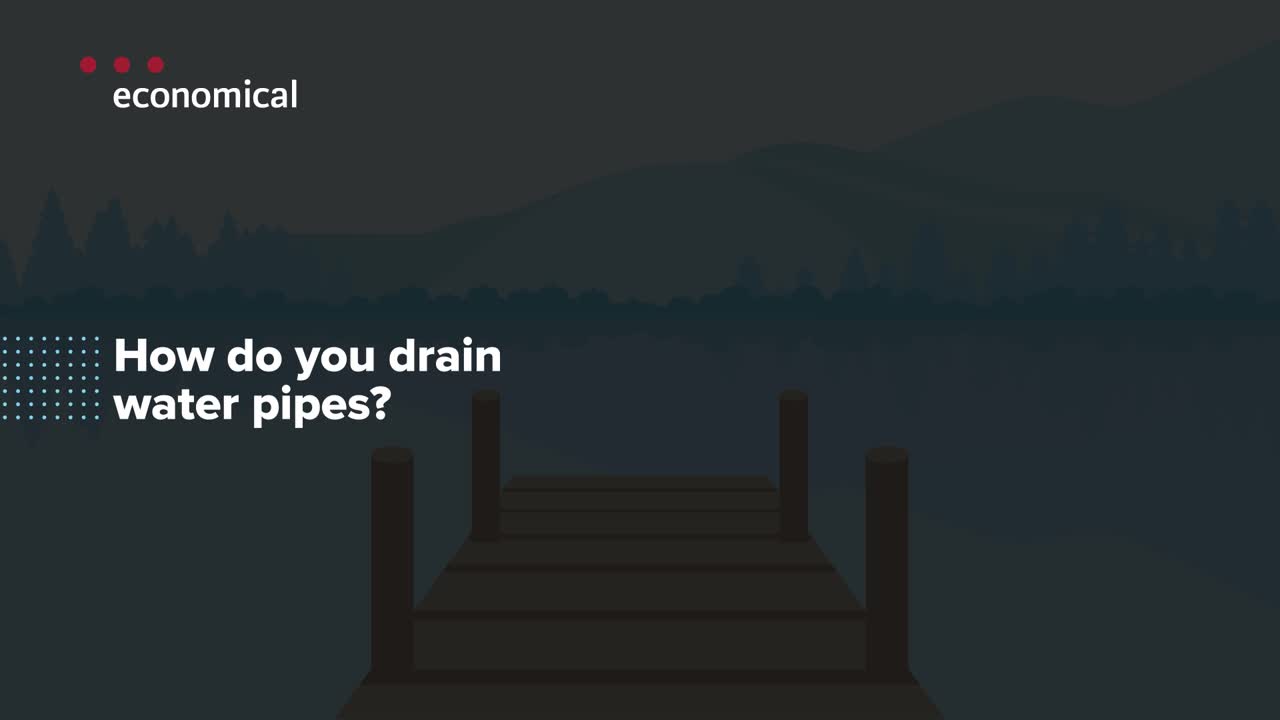Water damage is one of the leading causes of home insurance claims across Canada. Whether it’s caused by a sewer backup, a sump pump failure, the spring thaw, or burst pipes, damage caused by water can be costly and inconvenient to repair. Luckily, there are plenty of things you can do to protect your home against water damage. In the winter months, it’s especially important to take some simple steps to prevent your home’s interior and exterior pipes from freezing and bursting.
How to turn off your home’s water supply and drain indoor pipes
Whether you’re closing up your cottage for the winter or planning on taking an extended winter vacation, draining the pipes in your cottage or home can help prevent them from freezing (and possibly bursting) while you’re away. Draining your pipes is especially important if you’re planning on turning your furnace down to save electricity while you’re away or if the power goes out on a chilly day. Let’s take a look at how you can turn off your home’s water supply and drain your interior pipes:

Now let’s break it down in a little more detail:
- Find the shut-off point and turn off the water supply. The shut-off valve for your home’s water main is likely located in the basement, near your water meter or wherever the local water supply enters your home. Generally speaking, it will be on the wall that faces the street. If this shut-off valve is tap- or knob-style, turn it clockwise (to the right), to turn it off. If your shut-off valve is lever-style, turn the lever clockwise or in whichever direction the “off” arrow is pointing.
- Turn on the taps. Once you’ve turned off your home’s water supply, turn on the faucet in the lowest part of your basement first, then make your way upstairs and turn on the rest of the faucets, starting with taps on the top floor. Leave the faucets open.
- Remember to flush. Flush all of the toilets in your home, starting with toilets on the top floor and working your way down to the basement. Remove the tank cover from each toilet and hold the flush lever down until all of the water drains out of the tank.
- Anti-freeze it. Once all of the water has drained out of your faucets and toilets, pour some plumbing anti-freeze (available at your local hardware store) into all sink and bathtub drains, and into each of your toilet bowls. This should prevent any remaining drops of water from freezing.
- Empty your appliances. Depending on how long you’ll be away, you may also want to consider draining any appliances in your home that use water, including your washing machine, dishwasher, and water heater. Turn off the water supply to each of these appliances and follow the manufacturers’ recommendations for draining them.
When you’re planning on being away for longer than a few days, remember to arrange to have someone you trust check in on your home regularly just in case anything goes wrong, and take some simple steps to deter break-ins, too.
How to turn off and drain outdoor water lines and faucets
Before the first freeze of the season, be sure to turn off your home’s outdoor water supply and drain the exterior pipes, including any outdoor faucets and hoses:
- Locate and turn off the outdoor water shut-off valve. Your home’s outdoor water shut-off valve is usually located near the ceiling, on the inside of the wall where the outdoor faucet is located. If the outdoor shut-off valve is tap- or knob-style, turn it clockwise, or to the right, to shut it off (remember: righty-tighty, lefty-loosey). If it’s lever-style, turn the lever clockwise or in whichever direction the “off” arrow is pointing.
- Disconnect the hose. Turn off your outdoor faucet by turning the knob all the way to the right and disconnect your outdoor hose. If there’s a nozzle on the hose, turn it on so that any additional water can drain out of the hose before you store it for the winter.
- Drain the pipe. Once you’ve removed the hose, turn the outdoor faucet back on to allow any remaining water to flow out of the pipes. When the water stops flowing, turn the faucet off.
- Drain the inside valve. Return indoors and place a bucket under the shut-off valve, then open the drain plug to allow any remaining water to flow out of the valve. The drain plug usually looks like a small metal cap located on the side of the shut-off valve. Once all the water has drained out, close the plug or cap.
If your home has multiple outdoor water sources, you’ll need to repeat these steps for each one.
When in doubt, consult a plumber
Every home is unique, and depending on the setup of your home’s plumbing system, draining your indoor and outdoor pipes may require different (or additional) steps. The first time you drain your pipes, consider consulting a professional plumber to make sure you’ve covered all your bases.
If it’s been a little while since you’ve reviewed your home insurance policy, check in with your group’s licensed insurance broker to make sure you have the coverage you need to protect your home and your stuff in the event of a water mishap.
Want to help your neighbours prevent water damage this season, too? Share these tips on Facebook or Twitter.